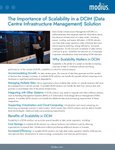In today’s business landscape, data is a kingmaker. But success isn’t achieved by simply possessing that data – without the ability to garner keen data-driven insights, the true value of organizational data is all but wasted.
In order for data to be most effectively analyzed and converted into meaningful insights, it must be properly “prepared” by data engineers – a process that includes data preprocessing (cleaning, integration, transformation, aggregation, format conversion, and reduction) and data wrangling (filtering, grouping, enhancing features and enhancing accuracy).
Unfortunately, for businesses dealing with data-intensive and complex workloads, data preparation can be even more time and cost-intensive than the analytic processing itself – today, data preparation processes are taking around 80 percent of a project's time and resources.
As the complexity of data workloads continues to grow, it belies the critical significance of "always-ready" data – data that can be rapidly prepared for analytic processing – and therefore, easily accessible and usable at nearly any time.
Data challenges for modern enterprises
For enterprises today, staying competitive includes their ability to prepare and make sense of data-intensive, high-complexity workloads. This means processing and analyzing as many as thousands of terabytes of new data per day to reap new insights and predictions.
“Per day” is the operative phrase here – as well as the primary hurdle. Timely insights are crucial for keeping pace with a rapidly evolving business landscape. But to stay up to date, enterprises must often compromise on the amount of data they are preparing. While that may increase the speed with which they produce important analysis, it is liable to hurt the overall quality and effectiveness of their data-driven business decisions.
Rapid data preparation
How exactly does data preparation work, and why is it so time- and resource-intensive?
There is no predefined method for preparing data. Rather, it is a process of trial and error depending on the data source as well as its intended use case. If the process takes too long, it prolongs the time from iteration to experimentation phases, eating up valuable resources along the way.
Every data pipeline defines its own performance requirements and service level agreement (SLA) response time – the minimum time that a business commits to facilitating a service or resolving an issue within a specific use case. For example, the frequency at which the dashboard refreshes and the details that are to be included in the dashboard.
To ensure data readiness for business purposes, enterprises would do well to accelerate data pipelines via automation, regularly checking for accuracy and reliability over time.
Flexibility for every scenario or requirement
Imagine living in a world where data is prepared on an ongoing basis – that is, data prepared so quickly, regardless of the amount, that it is always ready. Such a reality would enable enterprises to respond promptly to evolving business needs and unexpected challenges. Moreover, it would minimize backlogs of tickets and requests, granting data engineers time to be more proactive and productive.
One way to facilitate this is through the use of a cloud data lakehouse. With it, data can be prepared directly on cloud storage, without the long load times that ETL- or ELT-based (extract, load, and transform) data processing typically takes.
For enterprises that manage complicated and data-heavy workloads, the result is game-changing on multiple fronts. Agile data infrastructure underscored by superior cost performance will give enterprises an efficient means of adapting to changing market dynamics, new projects, and fluctuating customer demands.
Empowering ad-hoc analytics
Beyond the flexibility it grants data engineers, always-ready data also empowers them to conduct ad-hoc queries and analytics as a way to derive actionable insights and predictions on the fly. After all, if an enterprise’s data is “always ready,” critical decisions can be made in near real-time, thus providing a distinct competitive advantage.
And thanks to its compatibility with business intelligence tools, ad-hoc queries and analytics not only simplify data exploration but also expedite iteration testing, significantly shortening the time it takes to complete a project.
Future outlook
Data may be a key ingredient for business intelligence and success, but it takes more than just having data to compete effectively. Data engineers, data scientists, and business analysts must be able to unearth the “secret nuggets” locked within that treasure trove of data – and fast.
Fortunately, rapid data preparation can bring enterprises up to speed. With “always-ready” data, time-sensitive business decisions never need to be at the mercy of traditionally cumbersome data processing.
Shifting market forces influence the data modern enterprises have at their disposal – it’s up to them to extract the business insights buried within, and act accordingly.








